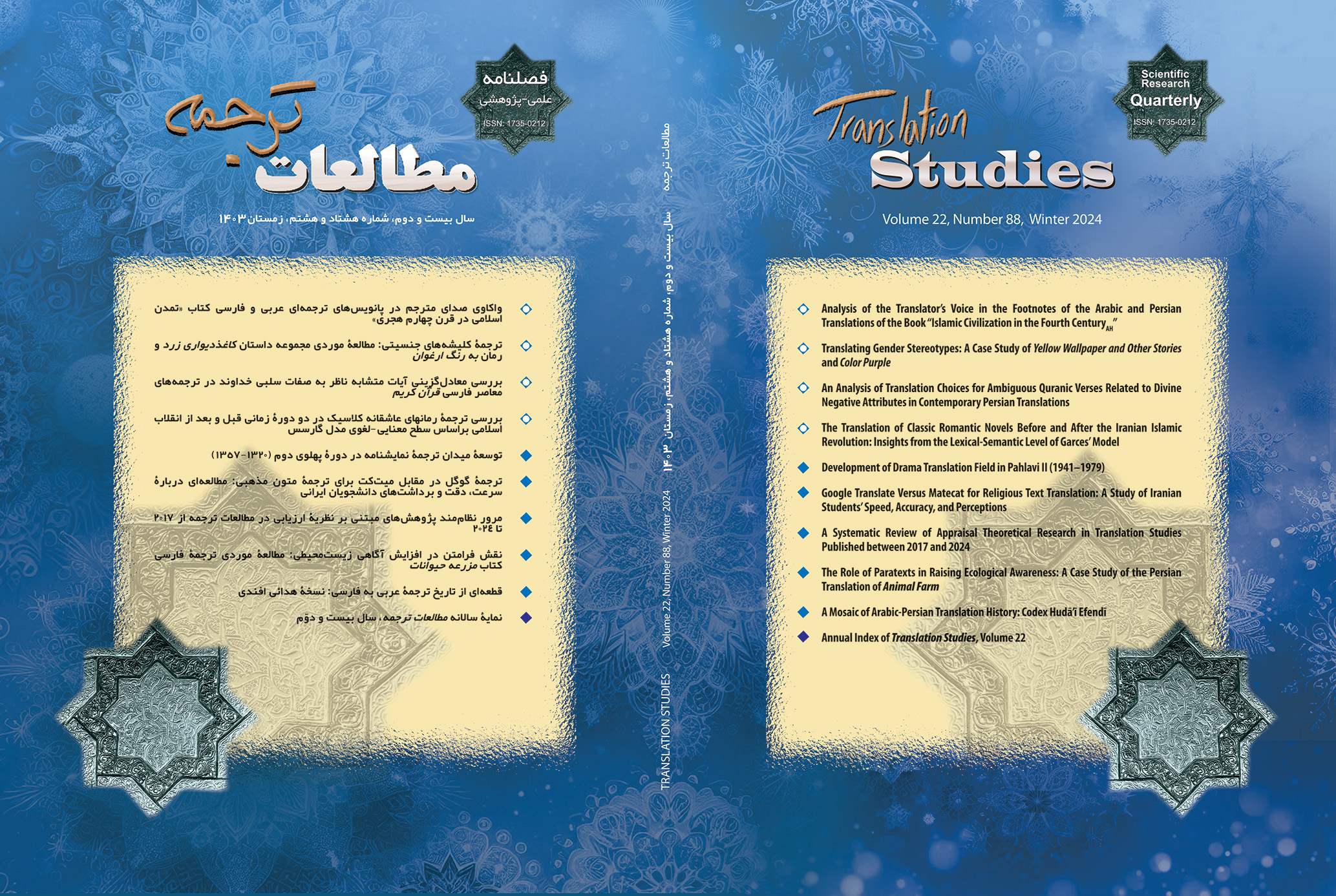Development of Drama Translation Field in Pahlavi II (1941–1979)
Abstract
This study, through the theoretical framework of Bourdieu’s sociology, examines the development of drama translation field in an Iranian context. Pahlavi II was a period of profound social, cultural, economic and political changes, which saw the structural transformation of Iran from an underdeveloped country into a developing society. The last two decades of Pahlavi II were the heyday of the drama translation. This diachronic study draws on archival material, following a socio-historical path, in order to reveal the roles of translators, artistic events, the state policies, and modernization of Iran to explain drama translation field development. The result of the research shows that this field was strengthened through the participation and cooperation of the state. The state offered opportunities to the participants and agents for agency. Accordingly, this period witnessed the homology between various agents and socio-cultural institutions which made the development of the field possible. In addition, drama translation developed from translating for stage to translating for page. All these technically enhanced the visibility and recognition of drama translation field and the value of this literary genre.
Keywords:
Agents, Drama translation field, Social fieldReferences
Abrahamian, E. (1983). Iran between two revolutions. Princeton University Press. pp. 123–163. ISBN 9780691053424. OCLC 7975938.
Aryanpur, Y. (1972). Az Saba ta Nima. Zuvar. [In Persian]
Boroujerdi, M. (1996). Iranian intellectuals and the West: The tormented triumph of nativism. Syracuse University Press.
Bourdieu, P. (1986). The forms of capital (H.M. Parshly, Trans.). In: Richardson, J. (ed.), Handbook of Theory and Research for Sociology of Education. Greenwood Press, pp. 46–56.
Bourdieu, P. (1996). The rules of art: genesis and structure of the literary field (S. Emanuel, Trans.). Polity Press.
Bourdieu, P. (1999). Practical reason. Stanford University Press.
Bozorgmehr, S. (2000). Influence of translation of dramatic texts on theater in Iran. Tebyan Publications. [In Persian]
Calhoun, C. (Ed.). (2002). Dictionary of social sciences. Oxford University Press.
Fanaeian, T. (2008). Performing art in Iran (till 1978). Tehran University Press. [In Persian]
Floor, W. (2005). History of theater in Iran. Kindle Edition: Amazon.
Ghaninejad, M. (2015). Modernization and development in contemporary Iran. Nashr Markaz. [In Persian]
Gouanvic, J. (2005). A Bourdieusian theory of translation, or the coincidence of practical instances. Translator, 11 (2), pp. 147–166.
Gouanvic, J. (2010). Outline of a sociology of translation informed by the ideas of Pierre Bourdieu. Mon, II (2), pp. 119–129.
Grenfell, M. (2008). Bourdieu: Key concepts. Acumen Publishing Limited.
Hanna, S. (2006). Towards a sociology of drama translation: A Bourdieusian perspective on translations of Shakespeare's great tragedies in Egypt. PhD Thesis. University of Manchester.
Huntington, Samuel P. (1968). Political order in changing societies. Yale University Press.
Inghilleri, M. (2005). Special issue on Bourdieu and sociology of translation and interpreting. Translator, 11(2).
Jenkins, R. (1992). Pierre Bourdieu. Routledge.
Johnson, R. (1993). Introduction. In: Bourdieu, P., the field of cultural production: Essays on art and literature. Polity Press.
Parastesh, Sh. (2014). Narrative of pure destruction: Bourdieusian analysis of the blind owl in the literary field of Iran. Saales. [In Persian]
Shirjian, F. (2002). The position of traditional plays in Persian contemporary theater. Aan. [In Persian]
Simeoni, D. (1998). The pivotal status of the translator's habitus. Target, 10 (1), pp. 1–39.
Tischler, H. (2007). Introduction to sociology. Montclair State University.
Torkaman, F. & Nasiripur, M (2016). Evaluating theater as an artistic field in Iran based on Bourdieu’s theories. Theater Journal of Art and Architecture.66, 61–76. [In Persian]
Tymoczko, M. & Gentzler, E. (2002). Translation and power. University of Massachusetts Press.
Venuti, L. (1995). The translator’s invisibility: A history of translation. Routledge.
Wolf, M. (2007). The location of "translation field". Negotiating Borderlines between Bourdieu and Homi Bhabha. In: Wolf, M. & Fukari, A. (eds.), Constructing a sociology of translation. John Benjamins.
Downloads
Published
How to Cite
Issue
Section
DOR
License
Copyright (c) 2025 Farideh Shabani Rad

This work is licensed under a Creative Commons Attribution-NonCommercial 4.0 International License.
Copyright Licensee: Iranian Journal of Translation Studies. This article is an open access article distributed under the terms and conditions of the Creative Commons Attribution–NonCommercial 4.0 International (CC BY-NC 4.0 license).





